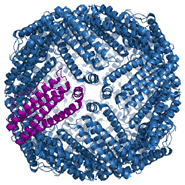Jul 23 2009
The first known example of a liquid protein has been made by chemists at the University of Bristol opening up the possibility of a number of medical and industrial applications including high-potency pharmaceuticals and protein-based coolants and lubricants.
Professor Stephen Mann and Dr Adam Perriman of the University's School of Chemistry, along with Helmut Cölfen of the Max Planck Institute for Colloid and Interface Research in Germany, have made a liquid form of the iron storage protein, ferritin. Their technique modifies the surface of the protein so that it melts into a viscous liquid.
The Bristol team attached positively charged amine groups to the surface of the ferritin, which then acted as binding sites for electrostatic attachment of a negatively charged polymer surfactant, creating proteins that bristle with long hairs. This ferritin-polymer composite forms a solid that melts at around 30°C to a liquid crystal with an orderly orientation of particles. When heated to 50°C, the liquid appears to act like an ordinary fluid, with disorder in the positions and orientations of particles.
The work has just been published in the chemistry journal, Angewandte Chemie, and preliminary results on other proteins such as haemoglobin and myoglobin - proteins that carrying oxygen around the body - indicate that the method may be of general application. 
The liquid protein is more highly concentrated than a protein dissolved in water which means that higher doses of medically useful proteins could be administered, for example in new wound dressing treatments which could deliver oxygen more efficiently to a wound in order to promote healing. Enzymes that break apart other proteins could also be used to clear wounds of debris from dead cells.
Professor Mann said: "This is a very exciting result with fundamental significance for understanding liquids comprising nanostructured components. Also, it represents a possible way forward to a novel state of biomolecular matter, and could therefore have a number of important applications. We hope to explore some of these - for example in biomedical and sensor technology - over the next five years or so."
This is a very exciting result with fundamental significance for understanding liquids comprising nanostructured components.
Professor Stephen Mann